Not being a driver when I first came out to Greece, I was used to walking everywhere I went. As a woman, I was wary of where I walked alone and what time I was walking. I always kept the street-wise rules in my mind, picked up in a self-defence class I took in Wellington: walk at a steady rate, as if you have somewhere to go; never loiter or act as if you are walking without a purpose. The roads in Wellington were much wider than those of Kolonaki. After work one evening, I saw a man approaching me in the opposite direction as I was walking up to the apartment. I quickened my pace (on the pretext, I suppose, that every male human being is a potential rapist), and started charging ahead on autopilot, like the evzones that push anything in their way aside when they march outside the Greek Parliament. As the man passed me, or as I passed the man, depending on one's point of view, he turned round to face me, and in a disgusted tone of voice, called out to me: 'What's the rush?"
The apartment was too small for three people to stay put in for a long period of time. To beat the boredom, if we were all at the apartment at the same time, we would sometimes go to the local kafeneio. For the price of a Greek coffee (or, as is still often heard in Hania, a Tourkiko), which at the time cost only 100 drachmas, making it the cheapest coffee available, we could stay in a cosy (if not exactly feminine) environment away from our own cage. One time, I remember going to the kafeneio during siesta time, which remained open for throughout the whole day. We ordered our coffees and picked up a tavli (backgammon) set.
"Not allowed," warned the kafetzis (the owner of the kafeneio).
"We can't play tavli" we asked with bewildered looks on our faces.
"No," the kafetzis repeated, giving no explanation, because that's part of the Greek way: you don't explain anything to anyone until the eleventh hour.
"Why?" we asked, in our foreign accents (Amerikanoi, the kafetzis probably thought).
"The sound of the pawns makes too much clatter," replied the kafetzis apologetically. The kafeneion was located in an area surrounded by apartment blocks. The other customers in the cafe (not everyone feels like napping, even if siesta is still a Greek tradition in many parts of the country) watched us as we silently made our exit, going to a noisier upbeat young people's cafe-bar (youth never sleeps), which had a lively atmosphere, but no backgammon sets.
And that was my introduction to the midday Greek siesta.
*** *** ***
During the midday siesta, it is forbidden by law to make any kind of noise whatsoever. Creating a disturbance is a punishable offence, and citizens are allowed to call the police to intervene if anyone or anything is disturbing the peace between the holy siesta hours of 3.00pm and 5.30pm. Being comfortably imbued in the Greek customs, I find that the midday siesta is an absolute must to recover from the searing heat of a summer's day: the weather at this time of year is usually very hot and uncomfortable; last year, temperatures reached over 45 degrees Celsius in some parts of the country.The midday siesta is perfect for avoiding the hottest part of the day. Without a midday siesta, it is impossible to fully enjoy a hot summer's night in Greece. Without partaking of the midday nap, life on a hot summer's day in the middle of the Mediterranean is simply stifling. You cannot enjoy your afternoon and you won't last into the evening. After spending a couple of hours lying down, we were refreshed enough to get a few jobs done in town in the afternoon, the time of which varies, with a general agreement by the masses that it starts at about 5.30pm (after the midday siesta) and finishes at about 8.00pm, depending on when the sun goes down. We had to:
- return some tiles for our latest home renovation project
- buy some more powder glue for the tiles (from the same store)
- pick up some wire scrub to clean the laid tiles (not from the same store -?!?)
- do some supermarket shopping, and
- drop off some old clothes and toys at St Nicholas Church in Splantzia, who distributes them to families in need.
When you come to Splantzia, you'll be overcome by an urge to explore. Splantzia is not your every-day inner-city suburb. St Nicholas church has a minaret attached to its side. You will want to find out why. An untidy-looking, seedy neighbourhood - it still houses Hania's red-light district, nicknamed Minoos due its proximity to the main street bearing that name - Splantzia is now the area of choice for economic migrants, with its cheap rents and international atmosphere; the sound of Greek is almost a rarity in amongst its alleyways and tiny houses, all sharing a wall with their neighbour.
The minaret is a reminder of what the town of Hania once was, and what it is slowly turning back into: a multi-ethnic town where many different cultures must learn to live beside each other and respect one another. Splantzia has always been the centre of multicultural activity in Hania. During the 400-year rule of the Ottomans, it was resided mainly by Turks. Now it's the place which tourists seek out if they want to see Hania town 'off the beaten track'. There is also another minaret in Splantzia, behind the area of the Agora.
Splantzia neighbours another inner-city suburb, the area known as Koum Kapi. As the name suggests, it was inhabited mainly by citizens with Turkish affiliations, until the time of the population exchanges precipitated by the Asia Minor crisis in 1922. The Turkish residents left many decades ago, but the names they had been using in Hania for four centuries still remain. Koum Kapi is still called Koum Kapi, and it doesn't look like it will change. Since we were in the district, we decided to enjoy our once-a-month family meal out at one of the dozens of al fresco eateries found there.
Koum Kapi, a coastal area located eastwards of the main town of Hania, takes is name from the Turkish language, meaning 'gate of sand', which refers to the eastern gate (still standing) built into the wall that surrounded the town to guard it and its citizens in older times. Before Ottoman rule, the Venetians had already named it Sabbionara, again meaning 'sand gate'. The bulwark is now covered with trees, and there used to be a cafe operating under their shade. I was lucky enough to enjoy the view from this spot; it has closed down now.
One hundred years ago, Koum Kapi's sandy shores were once covered in straw huts, homes to the 'χαλικούτιδες' (halikoutides), the moslem servant tinkerers of Arab-African descent, who left the town during the last major population exchange in 1922 after the burning of Smyrna. The photo shows their dwellings: a rather unusual structure inhabited by unusual people. This photo has been taken from the book Chania outside the Wall, by Aimilia Kladou-Bletsa.
Koum Kapi gradually turned into another quick-build shoddy-construction ghetto: rows of workers' houses, crammed beside each other like sardines in a can, one room tacked onto the other with no town planning taken into consideration. The area resembled a slum and was considered a 'bad' neighbourhood, the kind where illicit activities take place. The area underwent major re-imaging in the mid-90s; as soon as the slum housing disappeared and the coastal road was turned into a promenade suitable for the evening volta (stroll), along came the developers, turning it into a glitzy cafe-bar neighbourhood. Before this happened, this is what it looked like (again taken from Aimilia Kladou-Bletsa's fascinating book), a little as I remember it when I first came to Greece:
It is now the most vibrant part of town, and there is never an empty seat at the eateries in good weather. It stretches along the coast starting at the right of the touristy old port, the eastern side of the Venetian city wall which is still standing; an open-air theatre operates below it, in the area of a former moat, throughout the summer. Passing St Lucia's gate, Koum Kapi ends just behind the stately Villa Koundourou, a 100-year old house, used in former times by its owner as a country house getaway, subsequently bequeathed to the state by the owner, and presently used as an arts centre.
It seems that Koum Kapi is a well kept secret among the locals, as few foreign tourists are seen strolling along the promenade; while the locals walk slowly along the road enjoying the view and the misty breeze, the Northern European tourists jostle against each other for walking space at the old port in the high summer season.
It was a hot night, the theater in the moat was staging a children's play, the car park next to the theater - again housed in the moat - was choked with cars to full capacity. We were lucky to find a space near the entrance just as we were getting ready to leave it after driving right through it! This was the scariest part of the evening: getting through choking traffic with two youngsters in tow. But they weren't the only children being dragged to their parents' favorite hangout: my children met up with some of their friends from the day camp they have been attending. But the strollers were primarily young Greeks: smiling faces with bursts of laughter, all dressed in the latest fashion.
We took a walk along the promenade. The music coming from the bars, coupled with the style of the older houses, most of which have been renovated, will make you think you are on a backstreet in Havana. The food places were located closer to St Lucia's gate, while the open-air bars and cafes were found by Villa Koundourou. We walked back to find a seat in one of the little bistro-style tavernas, settling on the first place we found with empty seats. The sign above the indoor area gave its name as Kazimi. The seats were positioned next to the promenade, so that we had a direct view of the ocean, with the occassional spray of sea as the waves hit the breakwater. It felt fabulous to sit so close to the sea, but spare a thought for the locals: the music got louder and louder as the night wore on, and apparently no one goes home until well into the early hours of the morning...
We decided to order something simple: a mixed grill, more popularly known in Greek as a 'poikilia' (variety). There was a choice of small, medium and large: we chose medium for our family of two adults and two children.
'Anything to drink?' asked the not-very-talkative owner-waiter-cook.
'Two 'gazozes' for the children (locally produced cream soda), and a couple of ice-cold beers from the tap for us,' my husband replied.
'Sorry, I haven't yet bought the equipment for beer off the tap. We're new in the business, you see.' My husband was most disappointed. I wasn't too fussed; even if the food didn't come up to our expectations from this newly-opened eatery and its inexperienced owner, you have to see Koum Kapi for what it is: a good place to chill out. I wouldn't go to Koum Kapi otherwise. If all I wanted was good food, I'd stay at home. In any case, what we got for 31 euro, drinks included, was not just the food. There was also the intoxicating view and the lively atmosphere.
Admittedly, the food wasn't all home-made, judging by the chicken nuggets and uniform-sized schnitzel, but the meatballs were delicious, and the chicken souvlaki was the most succulent I had had in ages. The potato chips were crisp, but the sausages were the cheerio type, which would have gone down well at a children's party. As an added bonus, there was plenty to take home with us for the next day's lunch (2 kids count for 1 adult). It went well with the leftover boureki.

Funnily enough, I found myself at the same spot the next night with a friend. The bistro didn't fill up, while all the others around it were packed. Is this the effect I have on places?!
©All Rights Reserved/Organically cooked. No part of this blog may be reproduced and/or copied by any means without prior consent from Maria Verivaki.
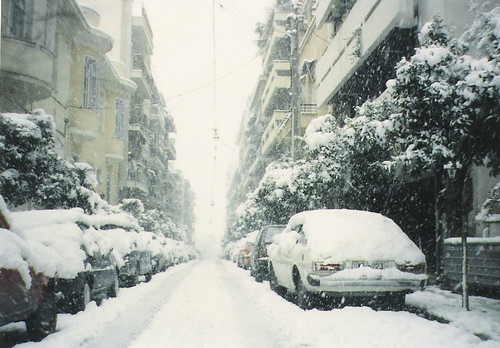
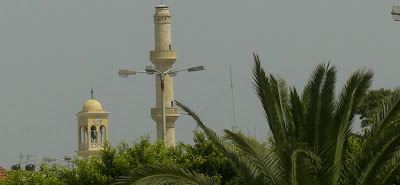
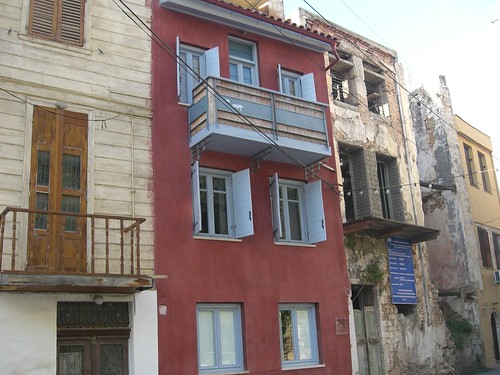
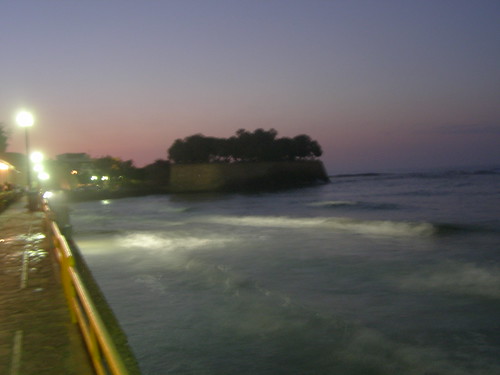
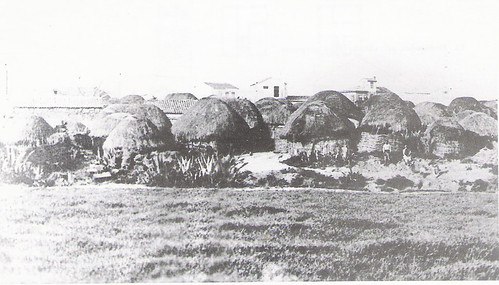



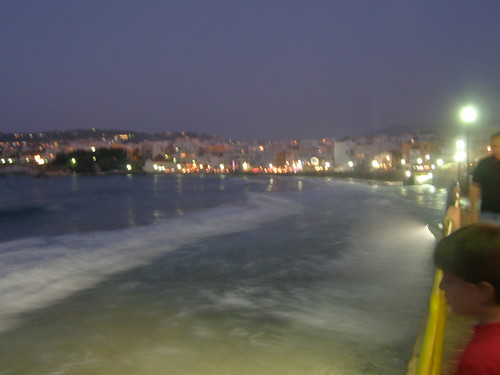
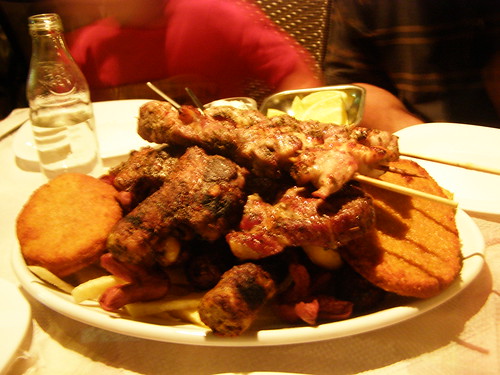
The post is wonderful as usual, but I am thinking that imposed siesta would be grand. More than grand. Grand enough I might have to move to a siesta country someday!
ReplyDeleteI often find I need a siesta, which is a real problem at work in a non-siesta country! (and it being Scotland, it's not like I have the excuse of being worn out by the heat!). I think the siesta is one of the very many hugely civilised things to come out of Greece!
ReplyDeleteWe saw many remnants of the Turkish occupation in Ioannina when we were there with towers and walled cities and the history of Ali Pasha on the island of Nissi.
ReplyDeleteIt is not such a bad idea to take a nap in the afternoon. It is so hot nothing productive is accomplished anyway without a great deal of airconditioning. As you said it keeps you going for the evening where dinner is very late in Greece...at least to my Canadian standards...wink...
ReplyDeleteI agree that the siesta is necessary since no one can move when it's so hot. Even if we don't sleep we tone it down a bit. BTW...nobody seems to care what time it is here in the sticks-machines run during siesta all the time!
ReplyDeleteKia ora Maria, this story reminds me of the time when I first arrived in USA from NZ. I am sure my eyes were as round as saucers for months as I adjusted to my new way of life. Just as you found when you moved away from New Zealand, we had many new things to learn and adjust to in our new surroundings. Now we are both used to it all. I for one, would not return to NZ to live as I am quite content here on Whidbey Island away from the hustle and bustle of city life.
ReplyDeleteOh, I loved this post. I've read it over and over. I really like looking at the old photos, and enjoyed learning about the history of the region. Those stone walkways add so much character to the area. It's too bad that the sand gate area has closed; I like to look at waves. The food looks awesome and how great that you had leftovers to enjoy the next day. Your comment about the bistro not filling up made me laugh. Another wonderful post from you. I just love seeing these areas through your eyes; it's like taking a blog trip to Greece!
ReplyDeletelovely post. thanks for taking me to a place i've never been to but would love! when i've gone to Spain, ciesta is so so important, we had to get used to the idea of businesses being shut down for some time. It's so worth it though.
ReplyDeleteglad to have found you.
Love your blog!
ReplyDeleteMrs M and I are back to Crete for the fourth time soon and we always spend some time in Hania, Koum Kapi, here we come.
I'm pretty sure the noise disturbance law isn't being enforced being as my neighbors are noisy 24/7. Calling the police won't help since they either don't come or they'd have to stay here 24/7 if they did.
ReplyDeleteBeautiful post, beautiful photos and beautiful memories.
I love the siesta law. So true what you said,
ReplyDelete"The midday siesta is perfect for avoiding the hottest part of the day. Without a midday siesta, it is impossible to fully enjoy a hot summer's night in Greece. Without partaking of the midday nap, life on a hot summer's day in the middle of the Mediterranean is simply stifling. You cannot enjoy your afternoon and you won't last into the evening."
Smart people. I know how good I feel after a couple of hours off on a hot day. Gives you the "second wind" to finish the rest of the day feeling great.
Loved this post.